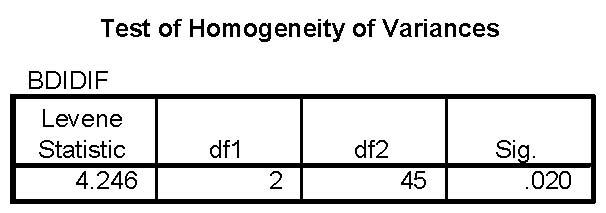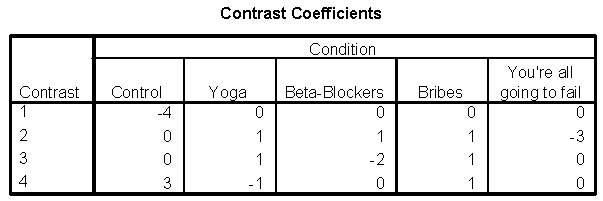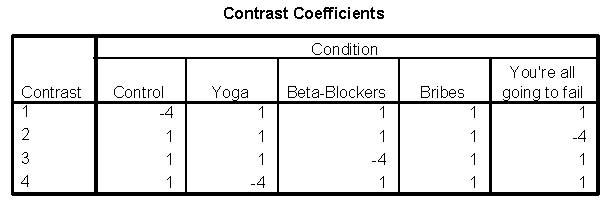An Adventure in Statistics: The Reality Enigma
Student Resources
Multiple choice questions
Quizzes are available to test your understanding of the key concepts covered in each chapter. Click on the quiz below to get started.
1. Imagine we wanted to look at predictors of popularity of famous sports people. We might hypothesize that the type of sport played would predict how popular the sports person was. Imagine we recruited 1000 participants and asked them to rate out of 10 (10 = They are the best sports person in the world, 0 = They are the worst sports person in the world) how much they liked 100 famous sports people from 10 different types of sports (10 sports people from each category). Could we analyse these data using regression, and if so how?
- No. We could not conduct a regression because our categorical predictor is made up of more than two categories.
- No. We can only analyse this scenario using ANOVA.
- Yes. To do this we would create 9 dummy variables for the ‘type of sport played’ variable.
- Yes. To do this we would need to create one coding variable for the ‘type of sport played’ predictor variable.
The correct answer is c) Yes. To do this we would create 9 dummy variables for the ‘type of sport played’ variable.
2. Which of the following sentences about grand mean centring in moderation analysis is not true?
- Centring is particularly important when your model contains an interaction term.
- Centring refers to the process of transforming a variable into deviations around a fixed point.
- Grand mean centring for a given variable is achieved by taking each score and subtracting from it the mean of all scores (for that variable).
- Centring the predictors will directly affect the b for the highest-order predictor, but will have no effect on the bs for the lowest-order predictors
The correct answer is d) Centring the predictors will directly affect the b for the highest-order predictor, but will have no effect on the bs for the lowest-order predictors. This sentence should read ‘Centring the predictors will have no effect on the b for the highest-order predictor, but will affect the bs for the lowest-order predictors’.
3. A psychologist was looking at the effects of an intervention on depression levels. Three groups were used: waiting list control, treatment and post-treatment (a group who had had the treatment 6 months before). The SPSS output is below. Based on this output, what should the researcher report?



- The treatment groups did not have a significant effect on depression levels, F(2, 26.44) = 4.35.
- The treatment groups had a significant effect on the depression levels, F(2, 26.44) = 4.35.
- The treatment groups had a significant effect on depression levels, F(2, 45) = 5.11.
- The treatment groups did not have a significant effect on the change in depression levels, F(2, 35.10) = 5.11.
The correct answer is b) The treatment groups had a significant effect on the depression levels, F(2, 26.44) = 4.35. This is because Levene’s test is significant, indicating that the assumption of homogeneity of variance has been violated. Therefore, we need to look at Welch’s F and the Brown–Forsythe F.
4. The student welfare office was interested in trying to enhance students’ exam performance by investigating the effects of various interventions. They took five groups of students before their statistics exams and gave them one of five interventions: (1) a control group just sat in a room contemplating the task ahead (Control); (2) the second group had a yoga class to relax them (Yoga); (3) the third group were told they would get monetary rewards contingent upon the grade they received in the exam (Bribes); (4) the fourth group were given beta-blockers to calm their nerves (Beta-Blockers); and (5) the fifth group were encouraged to sit around winding each other up about how much revision they had/hadn’t done (You’re all going to fail). The student welfare office made four predictions: (1) all interventions should be different from the control; (2) yoga, bribery and beta-blockers should lead to higher exam scores than panic; (3) yoga and bribery should have different effects than the beta-blocker drugs; and (4) yoga and bribery should also differ. Which of the following planned contrasts (with the appropriate group codings) are correct to test these hypotheses?
a. 
b. 
c. 
d. 
The correct answer is c) 
5. Imagine you compare the effectiveness of four different types of stimulant to keep you awake while revising statistics using a one-way ANOVA. The null hypothesis would be that all four treatments have the same effect on the mean time kept awake. How would you interpret the alternative hypothesis?
- At least two of the stimulants will have different effects on the mean time spent awake.
- All four stimulants have different effects on the mean time spent awake.
- None of the above
- Two of the four stimulants have the same effect on the mean time spent awake.
The correct answer is a) At least two of the stimulants will have different effects on the mean time spent awake. This is because if the F-ratio is large enough to be statistically significant, then we know only that one or more of the differences between means are statistically significant.
